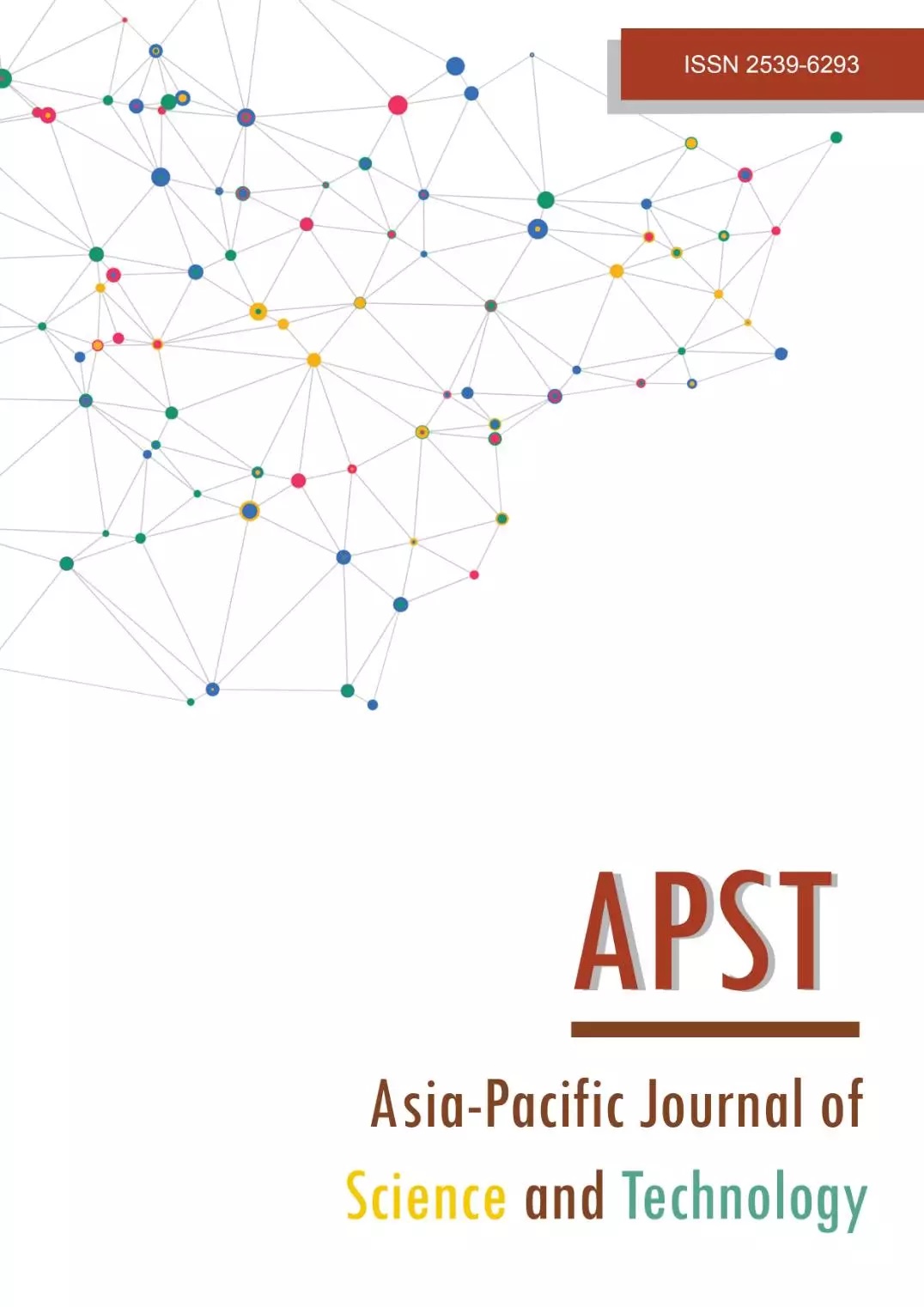Shelf life extension of pasteurized coconut milk using chitosan as a natural preservative
Main Article Content
Abstract
This research aimed to seek a natural food preservative by applying chitosan to preserve quality and extend the shelf life of pasteurized coconut milk. Coconut milk containing different concentrations of chitosan (0, 1, 3, and 5%(v/v)) were pasteurized at 72°C for 20 min and stored at 4°C. The changes in fatty acid (FFA), peroxide value (PV), pH, colors, total viable count (TVC), and sensory quality were monitored throughout the storage time. The shelf life was then evaluated using an accelerated shelf life test. The pasteurized coconut milk added with chitosan had lower FFA content, PV, TVC, and degree of phase separation than that without chitosan. These results indicated the ability of chitosan to retard lipolysis and lipid oxidation, inhibit microbial growth, and improve the stability of pasteurized coconut milk. Pasteurized coconut milk with 3% chitosan received the highest sensory scores, and thus its shelf life was further investigated using the temperature quotient (Q10) technique. Pasteurized coconut milk with 3% chitosan had a longer shelf life (7 days) than the control (2 days). Overall, chitosan can be used as a natural preservative to delay changes in the chemical, physical and biological quality of pasteurized coconut milk, while it did not show a negative effect on the coconut milk’s organoleptic quality. The opportunity of using chitosan as a natural food preservative is achievable.
Article Details

This work is licensed under a Creative Commons Attribution-NonCommercial-NoDerivatives 4.0 International License.
References
Seow CC, Gwee CN. Coconut milk: chemistry and technology. Int J Food Sci Technol. 1997;32:189-201.
Tangsuphoom N, Coupland JN. Effect of heating and homogenization on the stability of coconut milk emulsions. J Food Sci. 2005;70(8):465-470.
Birosel DM, Gonzalez AL, Santos MP. The nature and properties of the emulsifier system of oil globules in coconut milk and cream. Philipp J Sci. 1963;92(1):1-15.
Narataruksa P, Pichitvittayakarn W, Heggs PJ, Tia S. Fouling behavior of coconut milk at pasteurization temperatures. Appl Therm Eng. 2010;30:1387-1395.
Confederat LG, Tuchilus CG, Dragan M, Sha’at M, Dragostin OM. Preparation and antimicrobial activity of chitosan and its derivatives: a concise review. Molecules. 2021;26(12):3694.
Zivanovic S, Chi S, Draughon AF. Antimicrobial activity of chitosan films enriched with essential oils. J Food Sci. 2005;70(1):45-51.
Schreiber SB, Bozell JJ, Hayes DG, Zivanovic S. Introduction of primary antioxidant activity to chitosan for application as a multifunctional food packaging material. Food Hydrocolloids. 2013;33:207-214.
Siripatrawan U, Harte BR. Physical properties and antioxidant activity of an active film from chitosan incorporated with green tea extract. Food Hydrocolloids. 2010;24:770-775.
Pillai CKS, Paul W, Sharma CP. Chitin and chitosan polymers: chemistry, solubility and fiber formation. Prog Polym Sci. 2009;34:641-678.
Rabea EI, Badawy MET, Stevens CV, Smagghe G, Steurbaut W. Chitosan as antimicrobial agent: applications and mode of action. Biomacromolecules. 2003;4(6):1457-1465.
Feng T, Du Y, Li J, Hu Y, Kennedy JF. Enhancement of antioxidant activity of chitosan by irradiation. Carbohydr Polym. 2008;73:126-132.
The American Oil Chemists' Society (AOCS). Official method Ca 5a-40. In: Firestone D, editor. Official methods and recommended practices of the American oil chemists’ society. 4th ed. Illinois: AOCS Press; 1989.
Waisundara VY, Perera CO, Barlow PJ. Effect of different pre-treatments of fresh coconut kernels on some of the quality attributes of the coconut milk extracted. Food Chem. 2007;101:771-777.
U.S. Food and Drug Administration [Internet]. Maryland: The Agency; c1862-2022 [cited 2023 Feb 1]. Bacteriological analytical manual chapter 3: aerobic plate count. Available from https://www.fda.gov/food/laboratory-methods-food/bam-chapter-3-aerobic-plate-count.
Cardello AV, Jaeger SR. Hedonic measurement for product development: new methods for direct and indirect scaling. In: Jaeger SR, MacFie H, editors. Consumer-driven innovation in food and personal care products, Cambridge: Woodhead Publishing Ltd; 2010, p. 135-174.
Phimolsiripol Y, Suppakul P. Techniques in shelf life evaluation of food products: Reference Module in Food Sciences; 2016. Elsevier.
Industrial Standards Institute (TISI). Standard for coconut milk TIS 582-2528.2nd ed. Bangkok: TISI; 1985.
Ruengdech A, Siripatrawan U. Application of catechin nanoencapsulation with enhanced antioxidant activity in high pressure processed catechin-fortified coconut milk. LWT-Food Sci Technol. 2021;140:1-10.
Sun Y, Chen H, Chen W, Zhong Q, Shen Y, Zhang M. Effect of ultrasound on pH-shift to improve thermal stability of coconut milk by modifying physicochemical properties of coconut milk protein. LWT-Food Sci Technol. 2022;167:1-10.
Tarek MMH, Kamal MM, Mondal SC, Rahman ST, Abdullah MF, Awal MS. Changes in physicochemical properties of pasteurized coconut (Cocos nucifera) milk during storage at refrigeration condition. Thai J Agric Sci. 2020;53(3):150-164.
Tinchan P, Lorjaroenphon Y, Cadwallader KR, Chaiseri S. Changes in the profile of volatiles of canned coconut milk during storage. J Food Sci. 2014;80(1):C49-C54.
The Asian and Pacific Coconut Community (APCC). International codes and standard for aqueous coconut products. 2nd ed. Jakarta: APCC ;1994.
Raafat D, Bargen KV, Haas A, Sahl HG. Insights into the mode of action of chitosan as an antibacterial compound. Appl Environ Microbiol. 2008;74:3764-3773.
Rodrıguez MS, Albertengo LA, Agulló E. Emulsification capacity of chitosan. Carbohydr Polym. 2002;48(3):271-276.
Schulz PC, Rodriguez MS, Del Blanco LF, Pistonesi M, Agullo E. Emulsification properties of chitosan. Colloid Polym Sci. 1998;276(12):1159-1165.
Mirhosseini H, Tan CP, Taherian AR. Effect of glycerol and vegetable oil on physicochemical properties of Arabic gum-based beverage emulsion. Eur Food Res Technol. 2008;228(1):19-28.
Hafsa J, Smach MA, Mrid RB, Sobeh M, Majdoub H, Yasri A. Functional properties of chitosan derivatives obtained through Maillard reaction: a novel promising food preservative. Food Chem. 2021;349:1-12.
Rodsamran P, Sothornvit R. Physicochemical and functional properties of protein concentrate from by-product of coconut processing. Food Chem. 2018;241:364-371.
Choi JY, Lee HJ, Cho JS, Lee YM, Woo JH, Moon KD. Prediction of shelf-life and changes in the quality characteristics of semidried persimmons stored at different temperatures. Food Sci. Biotechnol. 2017;26(5):1255-1262.
Mizrahi S, Kilcast D, Subramaniam P. Accelerated shelf life testing of foods. In: Kilcast, D, Subramaniam P, editors. Food and Beverage Stability and Shelf Life. 1st ed. Cambridge: Woodhead Publishing Ltd; 2011. p. 482-506.


